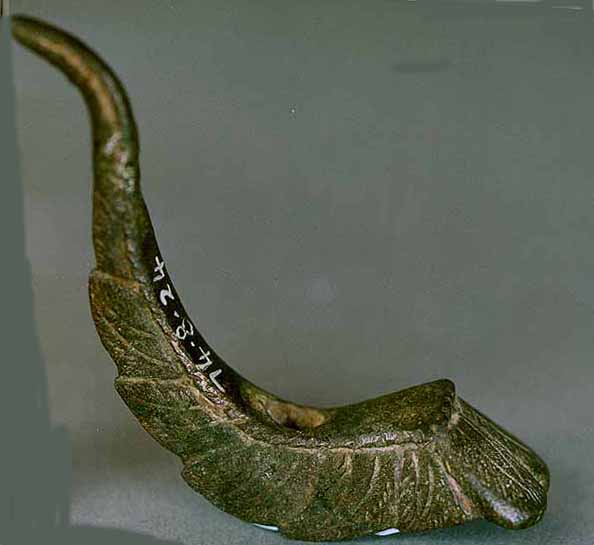|
|
Bronze Helmet-Crest of Figurine from Charlbury: 1st/2nd century AD |

The miniature crest, a double band of feathers or plumes in an S-shape, probably comes from a figurine of the god Mars or of the goddess Minerva (the Greek Athena) both of whom appear on several Romano-British figures. Although they appear dressed as warriors, their function was largely protective, battling against the diseases and crop failures which afflicted people.
A crest-holder supports the crest of the Greek-style helmet worn by the Mars figurine found in the Roman Foss Dike near Torksey in Lincolnshire and now in the British Museum. Mars, naked apart from the crested helmet, stands on a podium on which is inscribed the dedication to Mars. Statue and dedication were then apparently thrown into the river. The Torksey god's crest is a similar size to the one from Charlbury.
A figurine of Minerva from Alan’s Farm, Plaxtol, Kent is smaller but wears a similar helmet. Both figures were cast in one piece with their crests. The Charlbury crest, however, was detachable, but the sinking for the insertion of an element of the missing crest-holder is visible underneath the crest.
From about AD 60, the "imperial Gallic" type of helmet would have been in use in Roman Britain. Reinforced with or made entirely of iron, it was more decorative than its predecessor, but both types of helmets had fittings for crest-holders. The crests and holders were detachable and probably only used on parade. In this respect, the Charlbury crest is more true-to-life than the British Museum examples.
Images of deities were considered appropriate offerings also at shrines, of which there were a number in Roman Oxfordshire, including Woodeaton just outside Oxford, probably dedicated to Mars; a plaque from the shrine shows Mars wearing a crested helmet.
© 1998 Oxfordshire Museum Service, Setúbal Museums and the Benaki Museum